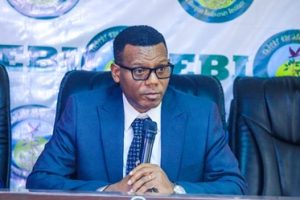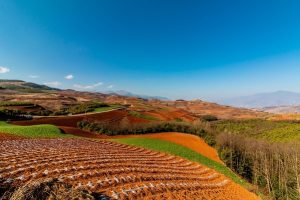
Ethiopia faces several natural and manmade challenges, such as droughts, floods, and insect infestations, which have a negative impact on both its people and ecosystems. It is also extremely vulnerable to climate unpredictability and change. The population and the ecosystem could also be severely affected as a result these challenges that requires environmental conservation measures.
Ethiopia’s government has been and is taking various measures to combat climate change and ensure sustainable development. The Green Legacy Initiative and the REDD+ Investment Program, which support the Climate Resilient Green Economy strategy, have significantly contributed to the nation’s re-greening, boosted livelihoods, decreased food insecurity, and increased climate resilience. Through green diplomacy, the programme not only benefits Ethiopia’s domestic goals but also strengthens ties with neighboring countries and promotes economic cooperation, peace, and stability.
Ethiopia’s forests are a source of food, wood, and medicinal plants, among numerous other necessities. They are also a cause for the creation of streams that supply freshwater apart from regulates climate change, flood, and soil erosion. Ethiopia’s forests and biodiversity are seriously threatened by deforestation, forest degradation, wildfires, diseases, pests, and alien species; thus, protecting them will require immediate action.
These efforts have not only contributed to sustainable forest management and climate resilience but have also fostered regional cooperation that ends up with economic growth of countries. Through collaboration among stakeholders, it is possible to gain due support of international donors.
The launch of Phase II REDD+ Investment Program represents a significant milestone in Ethiopia’s commitment to environmental conservation and climate change mitigation. The program, supported by international partners, particularly the Royal Government of Norway, plays a critical role.
Ethiopia has received substantial support from international partners, with Norway being a significant contributor. Over the years, the Norwegian government has contributed 130 million dollars to Ethiopia’s forestry development as part of their climate cooperation agreement, as to sources from Ethiopian Forestry Development(EFD)
According to EFD’s recent data, under the first Phase of REDD+ Investment Program, remarkable results has been recorded in reversing the loss of forest cover, enhancing forest-based economic and environmental benefits, promoting forest governance frameworks, and fostering cooperation among stakeholders.
The program has successfully protected natural forests, facilitated afforestation efforts, reduced carbon emissions, and preserved water and land resources due to the support of funds. These efforts have resulted in increased agricultural output and contributed to regional peace and stability.
Coordinator of the National Red Plus program, Yitebtu Moges (PhD), told to the Ethiopian Herald that the first Phase of the National Red Plus initiative has implemented since the end of 2017 with assistance from the Norwegian government and other partners.
According to Yitebitu in the first phase of REDD+ programme, using 75 million dollars funding from the Norwegian government, various forest resource recovery tasks were made participating the community. Accordingly, about one million hectares of land have been developed, rehabilitated, and turned into forests. Apart from increasing awareness of the community towards forest protection with this they are now start to use a range of technologies such as solar energy equipment, he added.
Regional initiatives have played a significant role in safeguarding and restoring the diminishing forest cover and rehabilitating damaged land in a nation.
In 41 districts of the Oromia region, efforts are being made to safeguard the naturally diminishing forest cover and recover damaged land. At the end of the first phase of the porgramme, some 400,000,000 hectares of forest are now covered with forest of various kinds, according to Debela Tesfaye, Oromia state REDD+ program coordinator.
The same true in amhara state said Sintayew Derese State’s Coordinator for the REDD+ program. Some 833 thousand hectares of land covered by forests and this in safeguard forests and restored land that has been run off by erosion, he said adding that the region’s carbon emissions had been reduced to 27 million metric tons.
In the second Phase of REDD+ Investment Program targets to restore degraded landscapes, protect biodiversity and carbon-rich forests, and reduce greenhouse gas emissions from deforestation and forest degradation. The program will leverage innovation, technology, and sustainable forest management practices to achieve its goals. The Government of Ethiopia, along with its partners, is committed to implementing the program and transforming the forestry sector. The integration of the REDD+ Program into the carbon market system will help Ethiopia secure funding by measuring the impact of global carbon emissions reduction efforts.
The REDD+ Investment Program offers significant economic benefits through carbon trading. Ethiopia, with its vast forested areas, has the potential to generate revenue by reducing carbon emissions and participating in the global carbon market. The program’s successful implementation will not only contribute to environmental conservation but also create employment opportunities, improve livelihoods, and support sustainable economic growth.
In the southwest region of Ethiopia alone, it was able to mitigate the emission of three million carbon credits annually in the forest cover. Yitebtu emphasized that 18 million carbon credits have been reduced between 2014 and 2020, and estimates indicate that the nation will generate more than 180 million dollars from carbon trade.
As to Debela, the Oromia region has an agreement with the World Bank that seeks to generate forty million dollars in carbon sales by 2030.
While Ethiopia has made significant progress in environmental conservation and sustainable forest management, several challenges remain. These include the need for continued community engagement, capacity building, and addressing underlying causes of deforestation and forest degradation, such as poverty and land-use conflicts. It is crucial for Ethiopia to continue its efforts, strengthen partnerships, and leverage technological advancements to overcome these challenges and achieve long-term sustainability.
Yitebtu mentioned that Phase II of REDD+ would require three years to implement and would cost forty million dollars; he stated that the government of Norway has contributed twenty-five million dollars.
He further stated that the Red Plus National Forestry Program will be integrated into the carbon market system as we move ahead. Also, he said that by measuring the effects of the global reduction in carbon emissions, the program will assist the nation in receiving funding.
The Phase II implementation of the REDD+ Investment Program marks a significant step forward in Ethiopia’s environmental conservation efforts, highlighting the country’s dedication to addressing global environmental challenges and contributing to a greener world.
A report shows that Ethiopia has lots of potential to boost the forest sector’s contribution to sustainable economic growth, with approximately 19 million hectares of forested area and plenty of land available for forest development. The government has been working with both bilateral and international partners to improve the sustainable use of forest resources.
In this sense, sustained collaboration, partnership, and the active involvement of local communities will be key to the success and long-term sustainability of these initiatives. With ongoing commitment and collective action, Ethiopia can serve as a model for other nations in their pursuit of environmental conservation and climate change mitigation.
BY FIKADU BELAY
THE ETHIOPIAN HERALD TUESDAY 28 NOVEMBER 2023




